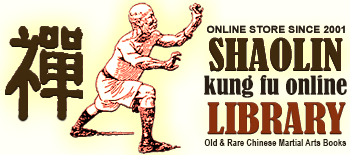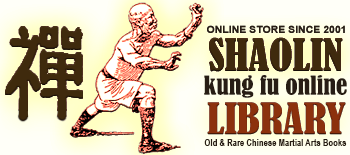
"As this kind of QUAN SHU (Pugilistic Art) is passed down to outsiders very seldom, there are only few people who know it. Being anxious that with time this style can be entirely lost, I recorded everything I knew from my tutors, wrote on paper my opinions based on personal experience and compiled this book for future generations."
"The author set himself the task to disclose all niceties of the style and described movements with so many details that it is possible to exercise independently of a master. This problem was successfully solved by him. Now those who have no tutor can train themselves with the aid of the book as if a flesh-and-blood tutor is beside them."
Xu Yi Qian.
Chuan Na Quan. Style of Piercing Blows and Holds (Shanghai, 1936).
Payment Methods: Credit Card (Visa, Mastercard, American Express, Discover, etc.), ShopPay, PayPal, GooglePay.
We use Shopify Payments, a trustworthy payment gateway providing the best security. Shopify is certified Level 1 PCI DSS compliant. This means that we meet all six categories of PCI DSS requirements.
Shopify Payments is one of the most secure payment processors available, so you can shop with confidence.
The digital edition of the book (eBook in PDF) is an exact copy of the printed version. After you order, you will get instant access to download the eBook. You will also receive an email with a link to the download page.
Chuan Na Quan. Style of Piercing Blows and Holds.

This style was founded by master Sha Da Chuan who passed it down to his son Zhan Wu. Zhan Wu, maintaining the tradition, passed it down to master Wu Bi You who, in his turn, passed the tradition down to masters Li Xue Qun, Cai Wen Quan, Xu Ran Deng, Xu Zhao Hui. During the years under the motto of Guang Xu (1875-1908) master Li Xue Qun passed the tradition down to Chen Fu Ren, Tang Li Ting, Ge Li Tang, Wang Jin Bo, Li Si Ran, Cai Shan Chung, Song Huan and Xu Yi Qian. In the 23-d year of the People's Republic (1934) Xu Yi Qian was appointed to a post at the editing department of the Academy of National Martial Arts. At that time he contributed to the propagation of the style by compiling the present book. In February of 1935 photos were made and the book was published in 1936.
About the Author

Xu Yi Qian. Nanking, 1935.
The author of the book Xu Yi Qian, alias Ji Liu, was born in Nantong in the province of Jiangsu. He finished an educational course at the Central Academy of National Martial Arts. Now works as an editor at the Central Academy of National Martial Arts. His father Xu Huai Deng and his tutor Li Xue Qun were school-mates at the school of master Wu Bi You. One might say with good reason that his family saw the very beginning of this Teaching.
/ Central Academy of National Martial Arts.
Publishing House Shan Wu Yin Shu Guan. Shanghai, 1936. /
"...I think writing books on martial arts requires the utmost exactness, briefness and clarity, so the reader could catch all nuances of movements and their combat employment at once. I always tried to proceed from actual situation, take into account practical training experience and compile a book on that base. Quintessence and innermost gist of this martial art are given in the book. The book includes actual movements, methods and techniques and does not contain idle talk and methods unfit for practical use.
Practice and theory must not be separated form each other. Now it often occurs that those who practice martial arts do not write books and writers do not practice them. Such editions are mere profanation. Their contents seem to be convincing only at first sight. Those editions do not represent true spirit of the national martial art; on the contrary, they distort its contents, widely disseminate incorrect views and opinions. It is very harmful. If it goes on in future, the idea of popularization of the national martial arts itself will be distorted beyond recognition."
/ 24-th year of the Chinese Republic (1935), winter, Nangking.
Written by Xu Yi Qian at the Academy of National Martial Arts. /
BOOK details
- Shaolin Kung Fu Online Library (USA, 2005)
- English
- PDF / 111 pages

Author's Preface.
CHUAN NA QUAN, a kind of the pugilistic art, was developed by master Sha Da Chuan from the town of Nantong. All movements of this kind of the pugilistic art were taken from the style TAI JI YUAN GONG; the oldest and respected specialist in it was master Wang Yue Qun, a fellow-townsman of Sha Da Chuan. During several decades this style was formed through reflection, training and practical experience. It is complicated enough, sometimes sequences of movements are unpredictable, therefore, it is difficult to understand the essence without a prior grounding.
The book contains 30 of the most effective methods from CHUAN NA and few techniques from the section SHAN DIAN SHOW ("Arms like lightning") of the style TAI JI YUAN GONG. We tried to shift the grain from chaff and show all that is the most valuable. All in all, fifty-five position are available, each of them is shown on a photo and supplied with detailed explanations on the execution of movements, movement directions, etc. I think writing books on martial arts requires the utmost exactness, briefness and clarity, so the reader could catch all nuances of movements and their combat employment at once. I always tried to proceed from actual situation, take into account practical training experience and compile a book on that base. Quintessence and innermost gist of this martial art are given in the book. The book includes actual movements, methods and techniques and does not contain idle talk and methods unfit for practical use.
As this kind of QUAN SHU ("Pugilistic Art") is passed down to outsiders very seldom, there are only few people who know it. Being anxious that with time this style can be entirely lost, I recorded everything I knew from my tutors, wrote on paper my opinions based on personal experience and compiled this book for future generations.







